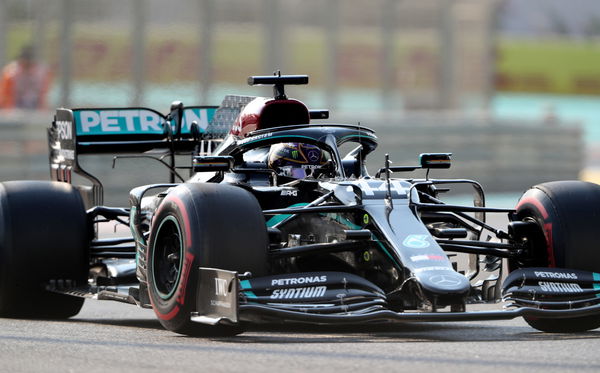
via Reuters
Formula One F1 – Abu Dhabi Grand Prix – Yas Marina Circuit, Abu Dhabi, United Arab Emirates – Mercedes’ Lewis Hamilton during practice Pool via REUTERS/Kamran Jebreili

via Reuters
Formula One F1 – Abu Dhabi Grand Prix – Yas Marina Circuit, Abu Dhabi, United Arab Emirates – Mercedes’ Lewis Hamilton during practice Pool via REUTERS/Kamran Jebreili
Every sport has its own set of rules and regulations. Naturally, F1 follows certain norms as well. The drivers ought to pickup rubber ahead of the race.
It is not an unknown fact that Constructors go through a process of weight-checking. Much like the drivers, their respective cockpits also need to pass through the same process, post racing.

via Reuters
Formula One F1 – Abu Dhabi Grand Prix – Yas Marina Circuit, Abu Dhabi, United Arab Emirates – December 13, 2020 Mercedes’ Lewis Hamilton in action after the race Pool via REUTERS/Hamad I Mohammed
Over the course of the race, the continuous friction and heat wear the tires out extensively. However, the bits and pieces of tires lying around the grid as debris that are further collected by the racers themselves.
ADVERTISEMENT
Article continues below this ad
The F1 supercars are needed to match a certain mark on the weighing chart to be on the list of the F1 Constructors’ chart. Subsequently, the cars go through an engineering process that restricts the car to weigh much.
Furthermore, the cars are loaded with high-end features and have advanced technology, all compacted in within limited use of space and weight.
Rules that F1 crews need to follow
FIA is very strict with its rules, especially the weight regulations that specify the minimum weight of the car before and after the race.
Every vehicle goes through the weighing process after the cool-down lap, at the end of the race. Making sure that none of them were running underweight while the race was going on. However, significant weight loss occurs during the race.
Mostly because of fuel consumption and tire degradation. Interestingly, the total weight measured is that of the car and the driver. It is a well-known fact that F1 cockpits are extremely hot, reaching about 45-50 degrees celsius.
As a result, the driver loses essential body fluids due to perspiration leading to almost 3 kgs’ weight losses.
ALSO READ- How Much Weight Do F1 Drivers Lose During a Race?

via Reuters
Formula One F1 – Abu Dhabi Grand Prix – Yas Marina Circuit, Abu Dhabi, United Arab Emirates – December 13, 2020 Red Bull’s Alexander Albon passes his team at the end of the race FIA/Handout via REUTERS
Hence the cockpit has a particular fluid storage system that provides the driver with the required hydrants through a straw and a pumping network within the driver’s helmet. A button activates the system on the steering.
Recovering all the lost weight is a tricky affair, and surprisingly, FIA rules permit it to take place. When you hear an engineer ask a driver to pick up marbles, it usually means that the driver must go over the sidelines, near the corners of the track. It is mandatory for every team to abide by the rules and build cockpits weighing a minimum of 782 kilograms.
Tips and tricks to F1 terminology
F1 cars can reach speeds of up to 230 mph, and this generates tremendous heat in the tires. By the end of the race, the tires have the consistency of chewing gum, ready to grab anything down on the road.
ADVERTISEMENT
Article continues below this ad
However, after swirling the checkered flag, the underweight cars are subjected to disqualifications. To compensate for the lost weight, drivers often go out of the sidelines, especially around the corners.

via Reuters
Formula One F1 – Abu Dhabi Grand Prix – Yas Marina Circuit, Abu Dhabi, United Arab Emirates – Ferrari’s Sebastian Vettel during practice Giuseppe Cacace/Pool via REUTERS
Rubber shreddings from tires accumulate outside the track. When the car moves over these pieces, the tires pick up the rubber quickly. Most often, the engineer predicts the weight lost and asks the driver to pick up the rubber.
ADVERTISEMENT
Article continues below this ad
To ace the race, the cars are crafted in a way weighing minimum to not affect the pace of it. However, in the course, there is a portion of weight loss that can further affect the weighing process. Hence, the drivers are required to pick up rubber from the grid to move forward in the event.
READ MORE- Everything You Need to Know About F1 Helmet Visors and How They Work in the Rain
ADVERTISEMENT
ADVERTISEMENT
ADVERTISEMENT
ADVERTISEMENT

